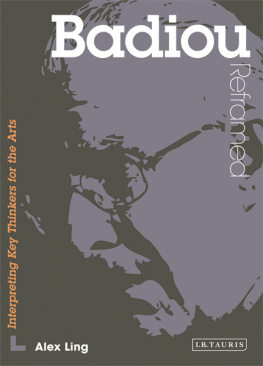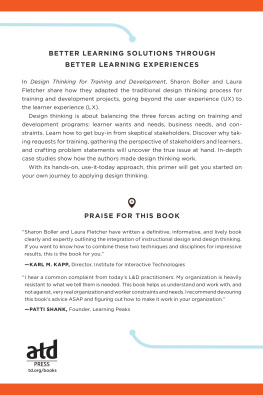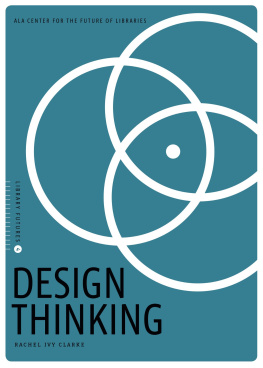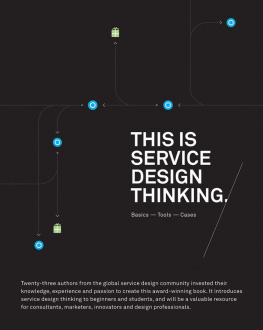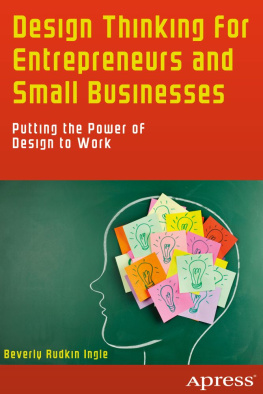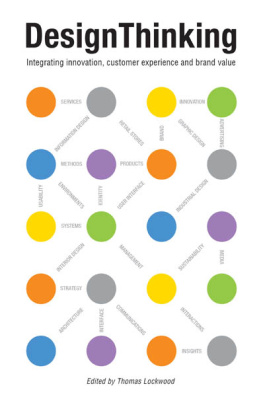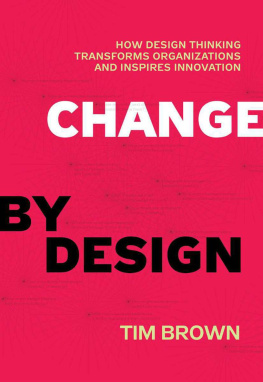COMPLETE DESIGN THINKING GUIDE
For Successful Professionals
Daniel Ling
Daniel Ling is one of the most innovative experience designers in Asia.This book gives you the tools he uses to make customers happy andbusinesses successful.
David McQuillen,
Customer Experience Pioneer & Entrepreneur
Copyright 2015 by Emerge Creatives Group LLP and Daniel Ling.
All rights reserved. Printed in Singapore. No part of this publication maybe reproduced, stored in a retrieval system, or transmitted, in any formor by any means, electronic, mechanical, photocopying, recording orotherwise, without the permission of the publisher.
Print ISBN: 978-981-09-5564-9
Formatted by Elizabeth Beeton, B10 Mediaworx
Please note: This ebook has been optimized for BlueFire Reader, available for PC, Mac, iOS, and Android, and Adobe Digital Editions.
For design thinking training workshops, talks or consultation with expertdesign thinker Daniel Ling, contact to discuss opportunities.
FOR JOLEEN AND CALEB
FOREWORD
BY DANIEL LING
Design must reflect the practical and aesthetic in business but above all...good design must primarily serve people.
Thomas J Watson, Industrialist
In Apples early days, Mike Markkula, one of its first investors, wrote aone-page memo dubbed The Apple Marketing Philosophy.
In particular, three points were stressed:
Empathy an intimate understanding of the customer. Markkula set down this marker to the rest of his team: We will truly understand their needs better than any other company.
Focus a defined and unwavering action plan. In order to do a good job of those things that we decide to do, we must eliminate all of the unimportant opportunities, said Markkula.
Impute belief that people will subconsciously judge a company, based on the product, its packaging and service by its staff. People DO judge a book by its cover, he wrote. We may have the best product, the highest quality, the most useful softwareif we present them in a slipshod manner, they will be perceived as slipshod; it we present them in a creative, professional manner, we will impute the desired qualities.
This memo, written in the early 1980s before the Macintosh launch, was insightful. These values really articulate what sets Apple apart from its rivals. Today, we can see that a lot of work goes into the product design and user interface design of an iPhone or a MacBook. Thought and focus goes into the way into its packaging, even the way the phone is taken out of the box. Deep empathy of customers is required to deliver a pleasant customer experience of purchasing music from iTunes.
Although he didnt realize it at that time, Markkula was writing about some of the fundamentals of design thinking.
ACKNOWLEDGEMENTS
BY DANIEL LING
I am a firm believer that everyone can be a designerthat we need more designers in a business suit.
I have close to 10 years of experience in innovation and design thinking in the area of the product and service design industrywho has moulded myself to be a designer in a business suitstrong in the design thinking process but yet relevant to business and financial industry. My years of experience in facilitation in workshops and training will bring practical knowledge to real life context.
I am driven by a vision to empower professionals and students with design thinking skills to be able to bring innovation and personal effectiveness to solve problems for the organization. And I do hope that by creating a book like thisI could share my knowledge as a design thinker to a larger audience, passionate about what they do and knowing that they too, can make a change in business or society.
I wish to personally thank the following people for their contributions to my inspiration and knowledge and other help in creating this book:
My wife Joleen and my son Caleb
For being patient and gracious in allowing me to give up some precious quality time with you, to spend writing this book. It wasnt easy.
My mentor and boss Bojan
For moulding and giving me opportunities to be moulded as one of the design and user experience experts in the industry.
Colleagues Mingjie and Jordan
For inspiring me to start writing this book. The inertia was great but I bucked it down after that inspiring coffee chat.
Illustrator Stefanie and Copywriter Han Hwee
Thanks for the support in making this book happen!
CONTENTS
Why do we need design thinking?
What makes design thinking unique?
Design thinking checklist
5 characteristics of action plan
Empathize phase
User feedback template
Personas template
Empathy map template
Define phase
Design brief template
Stakeholder map template
Customer journey template
Context map template
Opportunity map template
Ideate phase
Prioritistation map template
Affinity map template
Evaluate ideas template
Prototype phase
Physical prototype example
Wireframe example
Storyboard template
Test phase
User feedback template
Prototype evaluation template
Summary of 5 mindsets
Anatomy of a design thinker
Mindset 1: Think users first
Mindset 2: Ask the right questions
Mindset 3; Believe you can draw
Mindset 4: Commit to ideate
Mindset 5: Prototype to test
What are your users inherent needs?
How do you empathize your users?
Ask questionsWhat you need to know
Steps to take for preparing an interview
Persona
Empathy map
Why ask the right questions?
What are different type of questions?
Who should you ask questions?
How to align stakeholders in meetings?
Design brief
Stakeholder map
Customer journey
Context map
Opportunity map
Why should we communicate by drawing?
What is the value of drawing?
How to start drawing?
Visual library
Journey or process
Problem
Communication
How to start facilitation by drawing?
Why do you need to ideate?
What are the rules of ideation?
How to facilitate an ideation session?
How to build a creative culture?
Divergent5 common ideation techniques
Brainwriting
Nyaka method
NHK method
Scamper
What if?
Convergent3 simple ways to converge
Prioritisation map
Affinity map
Idea evaluation
What you could use as a prototype?
Why do we need a prototype?
Why do we test?
How to conduct a structured test?
How to conduct the interview?
How to conduct the observers debrief?
DESIGNS FUNDAMENTAL ROLE IS PROBLEM SOLVER.
FAST COMPANY, BUSINESS MAGAZINE
CHAPTER 1
WHATS DESIGN THINKING?
So what is design thinking, and how can this help us?
Design thinking is part and parcel ofwhat goes through a designers mind in every single design project. It is apowerful thinking tool that can drive a brand, business or an individualforward positively.
An example would be to take a gadget and ask, How do I makethis work, better, faster, smoother, and reduce waste and inefficiency? But itcan go beyond product design. You can scale it up and apply it to many things.For example, as more and more people come to cities to look for jobs, theseurban areas consumption of energy, food, water, and other natural resourceswill steadily increase.
This naturally places great pressure and stress not just onour environments, but on our daily living and routines (this goes a long way toexplain Singapores traffic jams, long queues, and overcrowded malls).
Design thinking can help solve problems with overcrowdedliving spaces, and minimize stress to our infrastructure. It can be used toutilize our resources effectively, and minimize energy consumption.



